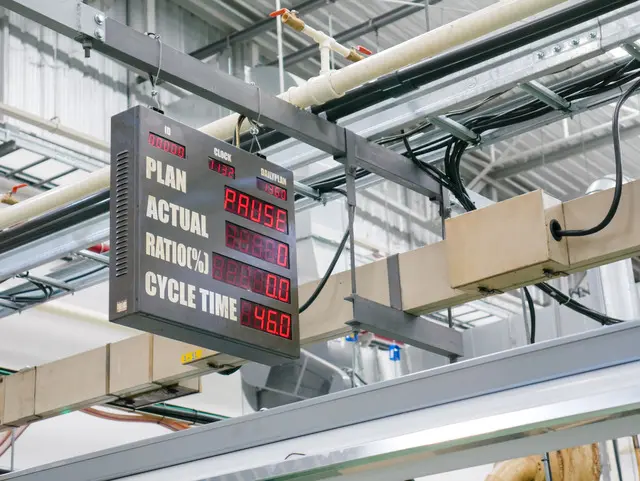Streamline Compliance Reporting with Automation: A Path to Efficiency and Accuracy
In today’s highly regulated manufacturing industry, compliance reporting is a critical yet challenging task. The complexities of regulations, the sheer volume of data to be collected and analyzed, and the tight deadlines for reporting make it a daunting endeavor. However, Compliance Reporting Automation offers a powerful solution to these challenges, empowering manufacturers to achieve efficiency, accuracy, and peace of mind.
By leveraging Python, AI, and cloud-based solutions, manufacturers can automate their compliance reporting processes, streamlining data collection, analysis, and reporting. This not only saves time and resources but also eliminates the risk of errors and omissions that can lead to penalties and reputational damage.
Benefits of Compliance Reporting Automation
- Reduced time and resources spent on manual reporting
- Improved accuracy and consistency in reporting
- Reduced risk of non-compliance and penalties
- Increased efficiency and productivity in compliance operations
- Enhanced visibility and control over compliance status
Conclusion
Compliance Reporting Automation is a game-changer for manufacturers looking to navigate the complex regulatory landscape efficiently and effectively. By embracing this technology, manufacturers can gain a competitive edge, ensure compliance, and focus on their core operations with confidence.

Python, AI, and Cloud: The Power Trio for Compliance Reporting Automation
Python for Unattended and Attended Bots
Python is a versatile programming language that excels in developing both unattended and attended bots for compliance reporting automation. Unattended bots can run autonomously, handling repetitive and time-consuming tasks without human intervention. Attended bots, on the other hand, collaborate with human users, providing assistance and automating specific tasks within existing applications.
The flexibility and customization capabilities of Python make it ideal for building bots that can adapt to the unique requirements of each manufacturing environment.
Cloud Platforms: Orchestrating Automation at Scale
Cloud platforms offer a comprehensive suite of features and capabilities that far surpass those of traditional RPA/workflow tools. They provide a scalable and cost-effective infrastructure for orchestrating complex automation processes, including compliance reporting.
Cloud platforms enable manufacturers to:
- Centrally manage and monitor all automation processes
- Leverage pre-built connectors and integrations with compliance management systems
- Access powerful AI and machine learning services
- Scale automation efforts as needed
AI for Enhanced Accuracy and Edge Case Handling
AI plays a crucial role in improving the accuracy and efficiency of compliance reporting automation. By leveraging techniques such as image recognition, natural language processing (NLP), and generative AI, manufacturers can:
- Automate the extraction and analysis of data from complex documents, such as invoices and contracts
- Identify and classify compliance-related information with high precision
- Handle edge cases and exceptions that may arise during the reporting process
Conclusion
The combination of Python, AI, and cloud platforms empowers manufacturers to achieve unprecedented levels of efficiency and accuracy in their compliance reporting processes. By embracing this powerful trio, manufacturers can gain a competitive edge, mitigate risks, and focus on driving innovation and growth.

Building the Compliance Reporting Automation with Python and Cloud
Sub-Processes of Compliance Reporting Automation
The compliance reporting automation process can be broken down into the following sub-processes:
- Data Collection: Gathering data from various sources, such as ERP systems, spreadsheets, and compliance management software.
- Data Analysis: Validating, cleaning, and analyzing the collected data to ensure accuracy and completeness.
- Report Generation: Creating compliance reports in the required format and structure.
- Report Submission: Submitting the reports to the appropriate regulatory bodies.
Automating Sub-Processes with Python and Cloud
Python and cloud platforms can be used to automate each of these sub-processes:
- Data Collection: Python scripts can be developed to extract data from various sources using APIs or web scraping techniques. Cloud platforms provide scalable storage and compute resources for handling large volumes of data.
- Data Analysis: Python libraries for data analysis, such as Pandas and NumPy, can be used to validate, clean, and analyze the collected data. Cloud platforms offer powerful data processing and machine learning services to enhance the accuracy and efficiency of data analysis.
- Report Generation: Python can be used to generate compliance reports in various formats, such as PDF, Excel, and XML. Cloud platforms provide document generation services that can be integrated with Python scripts to automate the report creation process.
- Report Submission: Python scripts can be used to submit reports to regulatory bodies via email or secure file transfer protocols. Cloud platforms offer managed services for secure file transfer and compliance reporting.
Importance of Data Security and Compliance
Data security and compliance are paramount in manufacturing, where sensitive information is often processed and stored. Python and cloud platforms provide robust security features, such as encryption, access control, and audit trails, to ensure the confidentiality, integrity, and availability of data throughout the compliance reporting process.
Advantages of Python over No-Code RPA/Workflow Tools
- Flexibility and Customization: Python is a versatile language that allows for greater flexibility and customization in automation development. This is especially important for compliance reporting, where the requirements can vary significantly across different industries and regulations.
- Scalability and Performance: Python and cloud platforms can handle large volumes of data and complex automation processes more efficiently than no-code RPA/workflow tools.
- Integration with AI and Machine Learning: Python provides seamless integration with AI and machine learning libraries, enabling manufacturers to enhance the accuracy and efficiency of their compliance reporting processes.
Algorythum’s Approach
Algorythum takes a different approach to business process automation by focusing on custom-built Python solutions rather than relying on pre-built RPA tools. This approach addresses the limitations of off-the-shelf automation platforms and provides clients with the following benefits:
- Tailor-made Solutions: Python-based automations are tailored to the specific requirements of each client, ensuring optimal performance and efficiency.
- Seamless Integrations: Algorythum’s automations seamlessly integrate with existing systems and processes, minimizing disruption and maximizing value.
- Continuous Improvement: Python-based automations can be easily updated and enhanced as business needs evolve, ensuring long-term value and ROI.
Conclusion
By leveraging Python, AI, and cloud platforms, manufacturers can build robust and scalable compliance reporting automations that improve efficiency, accuracy, and compliance. Algorythum’s custom-built Python solutions offer a superior alternative to off-the-shelf RPA tools, empowering manufacturers to achieve their compliance reporting goals effectively and efficiently.

The Future of Compliance Reporting Automation
The convergence of Python, AI, and cloud platforms is unlocking new possibilities for compliance reporting automation. Here are a few potential future developments:
- Real-Time Compliance Monitoring: AI-powered automations can continuously monitor business processes and data to identify potential compliance risks in real-time. This enables manufacturers to take proactive measures to mitigate risks and ensure ongoing compliance.
- Predictive Analytics for Compliance: Machine learning algorithms can analyze historical compliance data to identify patterns and predict future compliance risks. This information can be used to prioritize compliance efforts and allocate resources more effectively.
- Blockchain for Secure and Transparent Reporting: Blockchain technology can be integrated with compliance reporting automations to create a secure and transparent audit trail. This can enhance the credibility and reliability of compliance reports.
Conclusion
Compliance reporting automation is a rapidly evolving field, with new technologies emerging all the time. By embracing these technologies, manufacturers can gain a competitive edge, reduce risks, and focus on driving innovation and growth.
Subscribe to our blog to stay up-to-date on the latest trends and best practices in compliance reporting automation. Contact our team today to get a free feasibility and cost-estimate for your custom Compliance Reporting Automation requirements.

Algorythum – Your Partner in Automations and Beyond
At Algorythum, we specialize in crafting custom RPA solutions with Python, specifically tailored to your industry. We break free from the limitations of off-the-shelf tools, offering:
- A team of Automation & DevSecOps Experts: Deeply experienced in building scalable and efficient automation solutions for various businesses in all industries.
- Reduced Automation Maintenance Costs: Our code is clear, maintainable, and minimizes future upkeep expenses (up to 90% reduction compared to platforms).
- Future-Proof Solutions: You own the code, ensuring flexibility and adaptability as your processes and regulations evolve.









